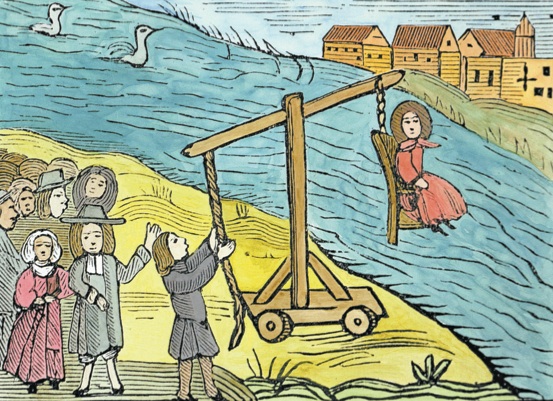Goody Garlick: The True Story of the Woman Tried for Witchcraft in East Hampton

In the middle of the seventeenth century in what was to become the United States, numerous communities rounded up suspected witches, put them on trial and, if convicted, punished them, sometimes burning them at the stake. It would be nice to be able to say that the colonial villages in the Hamptons were not among these communities. Unfortunately there was one that was. Since Halloween was just two days ago, I thought it might be a good idea to tell the story of East Hampton’s Goody Garlick, what she did, what she went through and what happened to her. This is a true story.
Eastern Long Island was inhabited only by Indians prior to 1639. It had not been visited before that date by settlers, although a Dutch explorer named Adriaen Block was the first European to sail in the Long Island Sound, and he produced a very inaccurate map of Long Island, which was, one supposes, the best he could do under the circumstances.
The Dutch did decide to settle near here. They built a colony on the tip of a deserted island they came upon just to the west of Long Island. They called it New Amsterdam, and the settlers, mostly businessmen and their families sponsored by the Dutch East India Company, engaged in trading with the Indians, farming and trapping. They would find things of importance for export, put them on ships and send them back to the homeland.
Although the first English settlement on Long Island was on the tiny island of the Isle of Wight, tucked in the bay just north of Amagansett in 1639, this settlement was more of a plantation. Lion Gardiner, who had come to the American colonies from England, was an engineer who designed and built forts. He built one at Saybrook, Connecticut to protect the settlers there during the Pequot War. He was a churchgoer. But as time went on, he got permission to create a new settlement on the Isle of Wight. Gardiner and his family and servants were rowed across Long Island Sound. Gardiner bought the Isle from the local Indians. The following year, and this was in 1640, more settlers had come to the eastern Long Island, first to Southold, then to Southampton. They had sailed here from Lynn, Massachusetts. But when some of these settlers moved eastward to found what would become East Hampton in 1648, they encountered Lion Gardiner. He was a powerful figure. Asked to lead, he not only led the town but also continued with his mansion and plantation on the Isle of Wight (its name soon changed to Gardiners Island.) He also built a big stone mansion, still standing, on Main Street in East Hampton.
In the years that followed, the Massachusetts Bay colony, often in a state of religious alarm, conducted witch hunts, rounding up suspected witches—agents of the devil living amongst the populace who, disguised as humans, could carry out evil projects—trying them and putting them to death. The settlers on Long Island were aware of this practice. But in East Hampton, they did something about it.
There was Goody Garlick, the wife of Joshua Garlick, who had at one time worked on the Gardiner Plantation. Goody Garlick was, by all accounts, a mean, nasty gossip who got through her day talking about people behind their back. Was she a witch? Nothing was done to find that out, at first.
In early February, 1657, however, something happened which hardened almost everybody’s opinion of Goody Garlick. At that time, Main Street consisted of two parallel dirt roads fifty yards apart from one another and about a mile long, with a row of houses on the north side of one and a row of houses on the south side of the other, facing one another. Between the roads was a broad grass center island where people often met to enjoy the day. It was thus a grand village. It is still a grand village today.
Early that February evening, a great tragedy began to unfold. Elizabeth Gardiner, the 16-year-old daughter of Lion Gardiner, became sick. Her new husband, Arthur Howell, was not at home at that time. When a friend, Sam Parsons, came to the door, she let him in and told him her husband was not at home, but he was welcome to come in anyway. As for her, she was feeling under the weather. Elizabeth’s husband soon arrived with a man named William Russell and seeing her in this state, insisted she go to bed, something she refused to do. She began to complain, petitioning to God to ease her suffering. She told her husband she was afraid she was losing her senses. And then she began to scream.
“A witch! A witch! Now you are come to torture me because I spoke two or three words against you. In the morning, you will come fawning.”
Her husband was terrified. He told Russell he hoped to God she wasn’t bewitched. Parsons was sent to bring Elizabeth’s father back.
“Oh get my father,” Elizabeth cried, “but don’t let my mother know.” With that, Elizabeth took to her bed. And Parsons rode off to tell Lion Gardiner what was happening. Mary his wife was in bed, also sick, with Lion attending her. But Lion Gardiner was so concerned, he left his wife and rode back to his daughter’s house with Parsons.
Through the night, Lion Gardiner stayed with his daughter. She was now running a fever. And she was delirious. She described a black thing at the foot of the bed, and she swatted at it. She was in a terrible state. In the morning, Lion returned to Mary and with the help of a neighbor, got her to her feet and off to her daughter. Elizabeth told her mother she was bewitched. Her mother told her she was only dreaming. Elizabeth persisted and her mother asked her to tell her what she saw, and Elizabeth said “Goody Garlick at one corner and a black thing at the other corner of the foot of her bed.” Her mother warned against telling anyone else, imcluding her husband, about her fragile mental state.
That next day, other women in the community came to see Elizabeth. She complained of being pricked with pins by Goody Garlick. She is a double tongued woman, she said.
“Ah, Garlick, you jeered me when I came to your house to call my husband home. You laughed and jeered me, and I went crying away. Oh, you are a pretty one!…Send for Garlick and his wife…I would tear her in pieces and leave the birds to pick her bones!”
And it went on and on. The women tried to cure her of the witchcraft that befell her with oil and sugar. They gave her some cough syrup. Soon after, a metal pin fell out of her mouth.
Elizabeth’s tribulations continued on into that next night. Those in the room at one point heard a sound coming from near the bed. They searched but couldn’t find a cause. And then Elizabeth died.
And in that instant, the people of East Hampton knew who had caused it and who should be burned at the stake.
The matter was moved to the meeting house and the magistrates assembled. Death sentences were appropriate punishments for both murder and witchcraft. There would be a trial. Goody Garlick was arrested and brought there. She did not speak in her defense. Eleven witnesses testified. Some testified of other suspicions they had about Goody Garlick. In the end, the magistrates were able to conclude that Elizabeth’s death had been caused by bewitchment and that Goody Garlick was responsible. Not only that, but Goody Garlick was connected to the deaths of four other persons via witchcraft, namely an unidentified man, a black child and two infants. Goody Simons had “fits” because of Goody Garlick. And animals were harmed or died, including a litter of piglets after a sow gave birth “strangely.” They also ruled that Garlick had caused an ox to break a leg. Indeed, only one person rose to defend Goody Garlick—her husband.
Just before the pronouncement of a sentence, Lion Gardiner, the man who had left his wife’s bedside, who had ridden across town to try to help his daughter, who was in a state of bereavement, intervened to defend Garlick against the onslaught of additional accusations.
Outside help would be needed with this, Lion Gardiner said. The magistrates thought: How can we, a small village of just a few magistrates not skilled in the Science of Demonology, make decisions involving life and death? And so, it was agreed to send the accused to the General Court of Connecticut, where “the occult doctrine would probably be more safely applied.”
So that’s where things went. In Hartford, after considering it all in an inquest lasting many days, the General Court in the May 1658 term declared Goody Garlick to not be guilty, as they did not consider there had been sufficient evidence to prove her guilt. She was ordered returned to East Hampton, at which point Lion Gardiner decided that she and her husband should move back to the plantation on Gardiners Island where he would find further employment for them there, which he did.
Both she and her husband lived there, in peace, the rest of their lives.
Did you have a bewitchingly good Halloween? Head to our Facebook or Twitter pages to share your favorite ghost stories, trick or treating memories and costumes.



